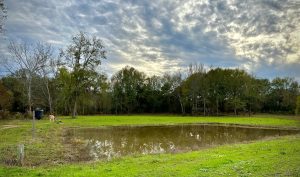Cutting Up Trees, Sowing Wildflowers
The blessed relief of cooler — sometimes downright cold — temperatures has given me much-needed energy to tackle a number of outdoor projects here at Three Geese Farm, which never lacks for things to do. On a brisk autumn morning in mid-November, I mowed everything that can be mowed one last time with the zero-turn — about six hours perched on that beast, noise-canceling ear buds playing music. There will be no more mowing with that Bad Boy (the actual name of this model) until May, after the wildflowers go to seed. That means I now have time for other tasks.
Speaking of wildflowers, I ordered three pounds’ worth from a wildflower seed company in Fredericksburg. My Beautiful Mystery Companion wanted them planted where she could admire them out her study window. I marked off a 60-foot-by-30-foot plot with orange flags, loaded up the hand spreader, strapped it around my shoulder and commenced to walking and spreading the seed. Two pounds are a wildflower mix of about two dozen different flowers that grow in our climate zone — Purple Coneflower, Black-Eyed Susan, Indian Blanket, and Shasta Daisy, to name a few. Just beyond that plot, I sowed a pound of Texas Bluebonnets.
Wildflower seed is not cheap. But this company comes highly recommended by a gardening columnist I trust. We hope to enjoy a nice carpet of wildflowers, to add to what grows o ut there naturally already, in the spring. Not that I am rushing matters. Fall and winter can loll around here as long as they want, since we all know what follows spring: Hell.
ut there naturally already, in the spring. Not that I am rushing matters. Fall and winter can loll around here as long as they want, since we all know what follows spring: Hell.
|—|
My “little” brother Gregg came over from the DFW area a few weeks back, his chain saw and .223 rifle in the backseat of his pickup. The late storm in June blew down five trees on the fence line along the creek in back, making the road along the creek impassable. At his directions, I bought a pair of forks that attach to the tractor bucket. They come in handy for a number of tasks. We were using them to stack up the trees we were cutting up. There is a washed-out spot alongside a culvert in back, to the point it is not possible to drive the tractor over the culvert. We dumped the cut-up limbs and logs in the gully to take up much of the space. Next step is getting a load of the largest rock I can buy and haul in the tractor to fill in around the wood. Then I’ll dump dirt on top of the rock. That should fix the gully, at least until the next time Witcher Creek overflows its banks.
As always, the chainsaws were being obstinate. We finally got them both going at the same time and managed to cut up five mature trees in a weekend with no limbs being severed. The only mishap was when one of the forks on the bucket caught me in the belly, not quite breaking the skin but leaving an angry slash. An inch closer, and it would have been a trip to the emergency room. Like baseball, hobby farming can be a game of inches.
|—|
After the first day’s work, Gregg and I grabbed dinner and then went hog hunting. Rather, he went hog hunting while I trailed behind. The hogs are back. I spotted about a dozen of them while walking down the driveway to begin my morning walk several weeks ago. So, we traipsed off into the woods in the dark, my green lumens flashlight strapped to Gregg’s rifle barrel, while I carried a normal torch.
We saw nothing except a giant spider that Gregg saved me from walking into. I don’t think it was poisonous, but that web plastered all over my face would have given me the willies. Both the hogs and that spider were unscathed that evening.
|—|
Since I am finished weed whacking until spring, I took our heavy-duty weed whacker to the shop and had them install The Blade on it in place of the string head. Most people do these types of changes themselves, but I have learned it is quicker to let a professional handle it. Since I am a good customer of this establishment – zero-turn mower, weed whacker and chainsaw, plus accessories – they swap it out for free. “Be careful,” the two brothers who run the place warned. “You can slice a toe off with that thing.” Let’s just say, they have gotten to know me.
Basically, this is a circular saw blade on the end of the weed whacker. It will cut through brush and saplings. I always wear heavy boots when using it and keep an eye on where my feet are located. In about two hours, I had cut down all the vegetation, most of it at least four feet high, that circled the edge of Pancho’s Pond and hauled it with the tractor to the burn pile. With the ryegrass coming on nicely, that area now looks like a park.
Onward and upward to the next project: clearing the fence lines with that blade. At least I can now work without breaking a sweat.
Leave a reply
Fields marked with * are required











